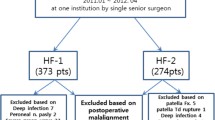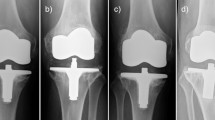Abstract
Purpose
We investigated the incidence, natural history, and functional consequences of a newly developed flexion contracture after total knee arthroplasty (TKA).
Methods
Forty patients with full knee extension preoperatively who developed a postoperative flexion contracture were match-paired 1:2 with 80 patients who had full extension. The incidence of a newly developed flexion contracture, ROM, and Knee Society scores (KSS) at six weeks, four months, and one year were analysed.
Results
The incidence of a new flexion contracture at six weeks was 14 %, but diminished to 5 % and 0.3 % at four months and one year, respectively. One year after surgery, there was no difference in the KSS (p = 0.5).
Conclusions
This study showed that the majority of patients who developed a new flexion contracture after TKA have full knee extension one year postoperatively. Moreover, knee extension and KSS at one year are equivalent to those patients who did not developed a flexion contracture.
Similar content being viewed by others
References
Goudie ST, Deakin AH, Ahmad A, Maheshwari R, Picard F (2011) Flexion contracture following primary total knee arthroplasty: risk factors and outcomes. Orthopedics 34:e855–e859. doi:10.3928/01477447-20111021-18
Lam LO, Swift S, Shakespeare D (2003) Fixed flexion deformity and flexion after knee arthroplasty. What happens in the first 12 months after surgery and can a poor outcome be predicted? Knee 10:181–185
Parvizi J, Tarity TD, Steinbeck MJ, Politi RG, Joshi A, Purtill JJ, Sharkey PF (2006) Management of stiffness following total knee arthroplasty. J Bone Joint Surg Am 88(Suppl 4):175–181. doi:10.2106/JBJS.F.00608
Quah C, Swamy G, Lewis J, Kendrew J, Badhe N (2012) Fixed flexion deformity following total knee arthroplasty. A prospective study of the natural history. Knee 19:519–521. doi:10.1016/j.knee.2011.09.003
Ritter MA, Lutgring JD, Davis KE, Berend ME, Pierson JL, Meneghini RM (2007) The role of flexion contracture on outcomes in primary total knee arthroplasty. J Arthroplasty 22:1092–1096. doi:10.1016/j.arth.2006.11.009
Scranton PE Jr (2001) Management of knee pain and stiffness after total knee arthroplasty. J Arthroplasty 16:428–435. doi:10.1054/arth.2001.22250
McPherson EJ, Cushner FD, Schiff CF, Friedman RJ (1994) Natural history of uncorrected flexion contractures following total knee arthroplasty. J Arthroplasty 9:499–502
Perry J (1990) Pathologic gait. Instr Course Lect 39:325–331
Tew M, Forster IW (1987) Effect of knee replacement on flexion deformity. J Bone Joint Surg Br 69:395–399
Scuderi GR, Bourne RB, Noble PC, Benjamin JB, Lonner JH, Scott WN (2012) The new Knee Society knee scoring system. Clin Orthop Relat Res 470:3–19. doi:10.1007/s11999-011-2135-0
Haas SB, Cook S, Beksac B (2004) Minimally invasive total knee replacement through a mini midvastus approach: a comparative study. Clin Orthop Relat Res 428:68–73
Hollister AM, Jatana S, Singh AK, Sullivan WW, Lupichuk AG (1993) The axes of rotation of the knee. Clin Orthop Relat Res 290:259–268
Olcott CW, Scott RD (2000) A comparison of 4 intraoperative methods to determine femoral component rotation during total knee arthroplasty. J Arthroplasty 15:22–26
Whiteside LA (2002) Soft tissue balancing: the knee. J Arthroplasty 17:23–27
Vulcano E, Gesell M, Esposito A, Ma Y, Memtsoudis SG, Gonzalez Della Valle A (2012) Aspirin for elective hip and knee arthroplasty: a multimodal thromboprophylaxis protocol. Int Orthop 36:1995–2002. doi:10.1007/s00264-012-1588-4
Kim J, Nelson CL, Lotke PA (2004) Stiffness after total knee arthroplasty. Prevalence of the complication and outcomes of revision. J Bone Joint Surg Am 86-A:1479–1484
Firestone TP, Krackow KA, Davis JDt, Teeny SM, Hungerford DS (1992) The management of fixed flexion contractures during total knee arthroplasty. Clin Orthop Relat Res 284:221–227
Magit D, Wolff A, Sutton K, Medvecky MJ (2007) Arthrofibrosis of the knee. J Am Acad Orthop Surg 15:682–694
Mitsuyasu H, Matsuda S, Miura H, Okazaki K, Fukagawa S, Iwamoto Y (2011) Flexion contracture persists if the contracture is more than 15 degrees at 3 months after total knee arthroplasty. J Arthroplasty 26:639–643. doi:10.1016/j.arth.2010.04.023
Schurman DJ, Parker JN, Ornstein D (1985) Total condylar knee replacement. A study of factors influencing range of motion as late as two years after arthroplasty. J Bone Joint Surg Am 67:1006–1014
Aderinto J, Brenkel IJ, Chan P (2005) Natural history of fixed flexion deformity following total knee replacement: a prospective five-year study. J Bone Joint Surg Br 87:934–936. doi:10.1302/0301-620X.87B7.15586
Cheng K, Dashti H, McLeod G (2007) Does flexion contracture continue to improve up to five years after total knee arthroplasty? J Orthop Surg (Hong Kong) 15:303–305
Cheng K, Ridley D, Bird J, McLeod G (2010) Patients with fixed flexion deformity after total knee arthroplasty do just as well as those without: ten-year prospective data. Int Orthop 34:663–667. doi:10.1007/s00264-009-0801-6
Tanzer M, Miller J (1989) The natural history of flexion contracture in total knee arthroplasty. A prospective study. Clin Orthop Relat Res 248:129–134
Gogia PP, Braatz JH, Rose SJ, Norton BJ (1987) Reliability and validity of goniometric measurements at the knee. Phys Ther 67:192–195
Insall JN, Hood RW, Flawn LB, Sullivan DJ (1983) The total condylar knee prosthesis in gonarthrosis. A five to nine-year follow-up of the first one hundred consecutive replacements. J Bone Joint Surg Am 65:619–628
Malkani AL, Rand JA, Bryan RS, Wallrichs SL (1995) Total knee arthroplasty with the kinematic condylar prosthesis. A ten-year follow-up study. J Bone Joint Surg Am 77:423–431
Rorabeck CH, Bourne RB, Lewis PL, Nott L (1993) The Miller-Galante knee prosthesis for the treatment of osteoarthrosis. A comparison of the results of partial fixation with cement and fixation without any cement. J Bone Joint Surg Am 75:402–408
Shoji H, Solomonow M, Yoshino S, D’Ambrosia R, Dabezies E (1990) Factors affecting postoperative flexion in total knee arthroplasty. Orthopedics 13:643–649
Tew M, Forster IW, Wallace WA (1989) Effect of total knee arthroplasty on maximal flexion. Clin Orthop Relat Res :168–174
Yoshino S, Shoji H, Komagamine M (1990) Full flexion after total knee replacement in rheumatoid arthritis. Int Orthop 14:13–16
Mehta S, Lotke PA (2007) Impact of surgeon handedness and laterality on outcomes of total knee arthroplasties: should right-handed surgeons do only right TKAs? Am J Orthop (Belle Mead NJ) 36:530–533
Faris PM, Ritter MA, Keating EM (1988) Sagittal plane positioning of the femoral component in total knee arthroplasty. J Arthroplasty 3:355–358
Fehring TK, Odum SM, Griffin WL, McCoy TH, Masonis JL (2007) Surgical treatment of flexion contractures after total knee arthroplasty. J Arthroplasty 22:62–66. doi:10.1016/j.arth.2007.03.037
Perry J, Antonelli D, Ford W (1975) Analysis of knee-joint forces during flexed-knee stance. J Bone Joint Surg Am 57:961–967
Walton NP, Jahromi I, Dobson PJ, Angel KR, Lewis PL, Campbell DG (2005) Arthrofibrosis following total knee replacement; does therapeutic warfarin make a difference? Knee 12:103–106. doi:10.1016/j.knee.2004.06.004
Funding source
This study was partially funded by the generous donation of Mr. Glenn Bergenfield and the Simon Foundation.
Conflict of interest
The authors declare that they have no conflict of interest.
Author information
Authors and Affiliations
Corresponding author
Rights and permissions
About this article
Cite this article
Anania, A., Abdel, M.P., Lee, Yy. et al. The natural history of a newly developed flexion contracture following primary total knee arthroplasty. International Orthopaedics (SICOT) 37, 1917–1923 (2013). https://doi.org/10.1007/s00264-013-1993-3
Received:
Accepted:
Published:
Issue Date:
DOI: https://doi.org/10.1007/s00264-013-1993-3




